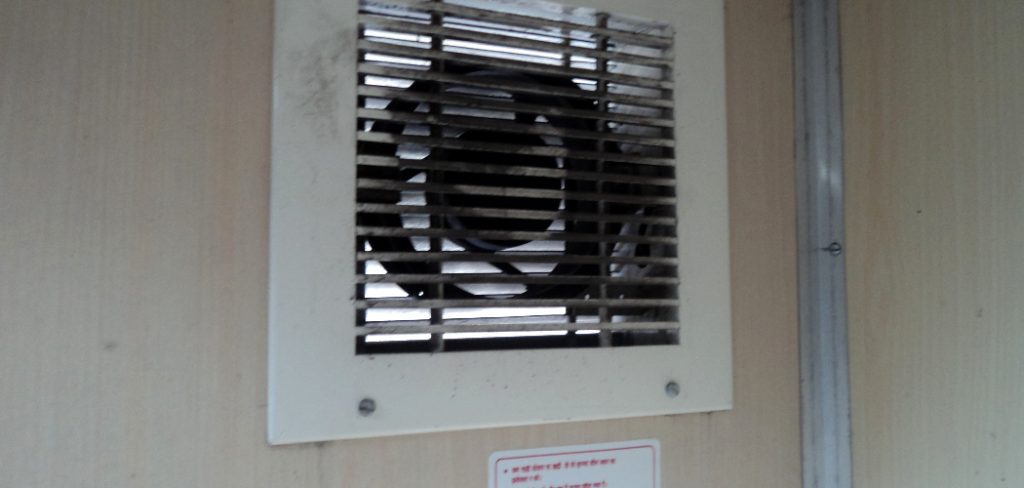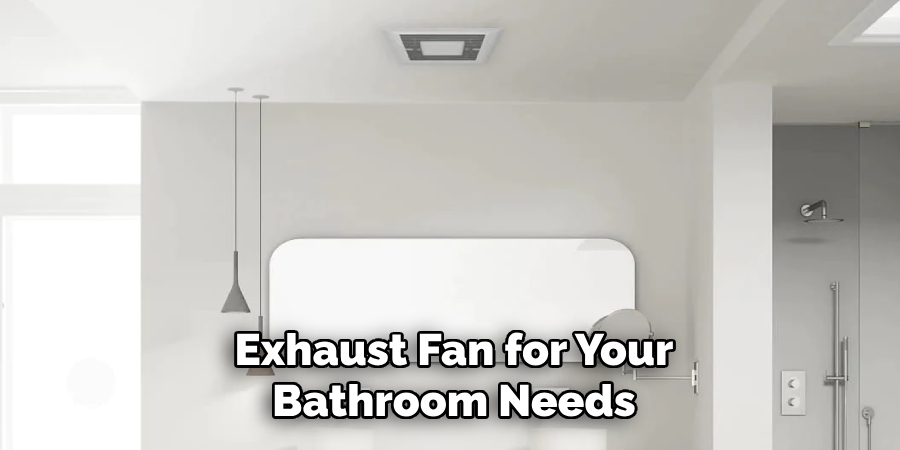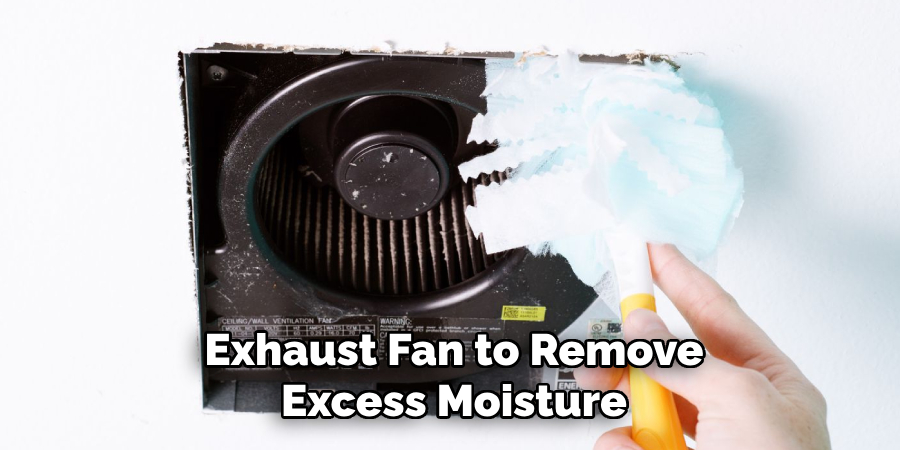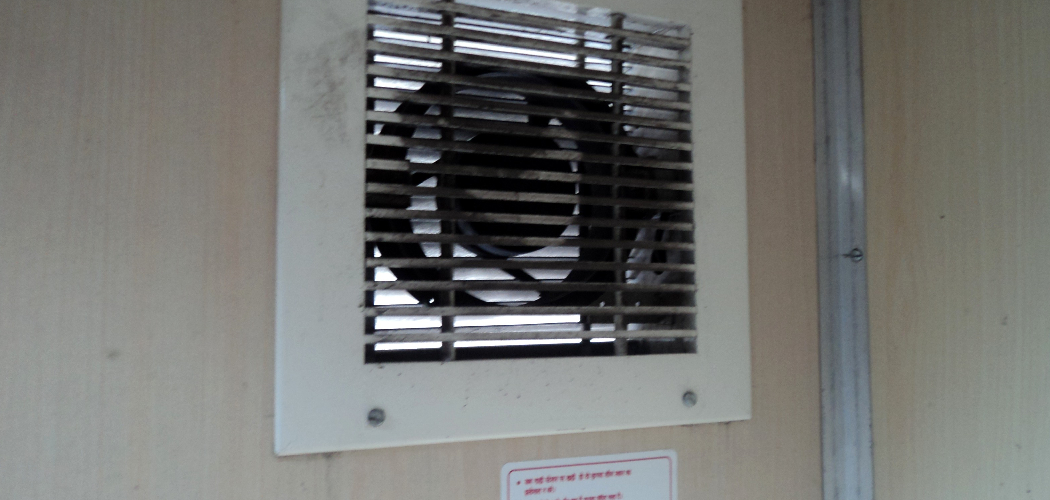Proper ventilation is crucial in any bathroom to maintain a healthy and comfortable space. One of the most important elements of bathroom ventilation is the exhaust fan, which helps remove moisture, odors, and bacteria from the air.

Installing a correctly sized bath exhaust fan can improve overall indoor air quality, prevent mold and mildew growth, and even prolong the lifespan of your bathroom fixtures. In this guide, we will discuss the steps on how to size a bath exhaust fan for your bathroom. So, let’s get started!
Understanding the Importance of Proper Ventilation
Before discussing the specifics of sizing a bath exhaust fan, it’s essential to understand why ventilation is crucial in bathrooms. Bathrooms are among the most humid spaces in any home due to daily activities like showering and bathing.
This high humidity level can lead to mold and mildew growth, which damages your bathroom and poses health risks. Additionally, bathrooms are often used for personal hygiene activities that produce unpleasant odors and bacteria, which can linger in the air if not properly ventilated.
Supplies You Will Need to Size a Bath Exhaust Fan
- Measuring tape
- Calculator
- Pen and paper (or a smartphone to take notes)
- A ladder or step stool (if your bathroom has high ceilings)
- A basic understanding of your bathroom’s layout and dimensions
Step-by-step Guidelines on How to Size a Bath Exhaust Fan
Step 1: Measure the Bathroom’s Square Footage
The first step in sizing a bath exhaust fan is to measure your bathroom’s square footage. You can do this by using a measuring tape and calculating the length and width of your bathroom in feet. Then, multiply the two numbers to get your bathroom’s total square footage.

Example: If your bathroom is 10 feet long and 8 feet wide, your total square footage would be 80 square feet.
Step 2: Determine the Required Airflow
The required airflow for a bath exhaust fan is measured in cubic feet per minute (CFM). The recommended CFM for an average-sized bathroom is based on the bathroom’s square footage. To determine the required airflow for your bathroom, you can use this formula:
Required Airflow (CFM) = Bathroom Square Footage × 1.1
Example: For a bathroom that is 80 square feet, the required airflow would be 88 CFM.
Step 3: Factor in Additional Features
In addition to your bathroom’s basic ventilation needs, it’s essential to consider any additional features that may require more powerful ventilation. For example, if your bathroom has a separate shower or steam room, you may need to increase the required airflow by 50%. Similarly, if your bathroom has high ceilings (9 feet or higher), you will also need to adjust the airflow accordingly.
Step 4: Choose the Right Fan Size
Once you have determined the required airflow for your bathroom, you can choose a bath exhaust fan that meets your needs. Fans are typically sized by their CFM rating and come in various sizes, from 50 CFM to over 100 CFM.
To ensure efficient ventilation, choose a fan with a slightly higher CFM rating than what you calculated in step two. Choosing the right size fan also depends on your bathroom’s layout, as certain areas may require more powerful ventilation compared to others.
Step 5: Consider Sound Levels
While a fan’s size and CFM rating are crucial factors, it’s also essential to consider its sound levels. A loud or noisy exhaust fan can be bothersome, especially if you have a smaller bathroom. Look for fans with lower ones (a measurement of sound levels) to ensure quiet operation. Be sure to check for additional features that may help reduce noise, such as insulated ducts or vibration-reduction mounts.
Following these steps will help you properly size a bath exhaust fan for your bathroom. Remember to always choose a fan with a higher CFM rating, factor in any additional features, and consider sound levels for an efficient and comfortable bathroom space.
With the right-sized exhaust fan, you can maintain good indoor air quality and ensure a healthy and pleasant bathroom experience. So go ahead and tackle this home improvement project with confidence! Happy ventilating!
Additional Tips and Tricks to Size a Bath Exhaust Fan

- If you need clarification on the size of your bathroom, it’s always better to choose a larger fan. This will ensure that your bathroom is ventilated correctly and reduce the risk of mold and mildew growth.
- Before purchasing an exhaust fan, consider its noise level. If you have a small bathroom, opt for a quieter fan, while a larger bathroom may require a higher CFM and noise level to ventilate the space properly.
- If your bathroom has a shower or bath, you’ll want to ensure the exhaust fan is rated for wet locations. This means it can handle moisture and steam without becoming damaged.
- To maximize efficiency, install the exhaust fan as close to the source of humidity (shower, bath, etc.) as possible. This will help remove the moist air before it spreads throughout the bathroom.
- Clean and maintain your exhaust fan regularly to ensure proper functioning. Dust and debris can build up on the fan blades, reducing their effectiveness and increasing noise levels.
- Consider installing a timer or humidity sensor with your exhaust fan for added convenience and energy efficiency. The timer can automatically turn off the fan after a set amount of time, while the humidity sensor will activate the fan when moisture levels rise.
- If you have a larger bathroom or multiple sources of humidity (e.g., shower and bath), consider installing multiple exhaust fans for more effective ventilation.
- Check building codes and regulations before installing your exhaust fan, as some areas may have specific fan sizes and installation requirements.
- If you need more confidence installing the exhaust fan, hiring a professional to ensure proper installation and function is always best.
- Lastly, remember to regularly check and replace the exhaust fan’s filter, if applicable. A clogged or dirty filter can reduce airflow and decrease the fan’s effectiveness.
Following these additional tips and tricks can help you properly size and install a bath exhaust fan for optimal ventilation and comfort in your bathroom. Remember, a well-ventilated bathroom is more pleasant to use and helps maintain the overall health of your home by preventing mold and mildew growth. Proper ventilation is crucial for improving your bathroom experience. So, make sure to keep these tips in mind when choosing and installing a bath exhaust fan. Happy ventilating!

Things You Should Consider to Size a Bath Exhaust Fan
1. The first thing to consider is the size of your bathroom. The larger the bathroom, the more powerful your exhaust fan must be. A small bathroom with a volume of 50 square feet will require an exhaust fan with a minimum airflow rate of 50 cubic feet per minute (CFM).
On the other hand, a larger bathroom with a volume of 100 square feet will require an exhaust fan with a minimum airflow rate of 100 CFM. It is important to determine the volume of your bathroom before selecting an exhaust fan.
2. Another factor to consider is the type of bathroom and its usage. A full bathroom with a shower or bathtub generates more moisture and steam, requiring a more powerful exhaust fan than a half bathroom with just a sink and toilet. If your bathroom is frequently used or prone to humidity, choosing a higher CFM-rated exhaust fan is recommended.
3. Noise level is another important aspect to consider when selecting an exhaust fan for your bathroom. Most exhaust fans have a noise rating measured in sones, with a lower number indicating quieter operation.
A quiet exhaust fan can make a big difference in a small bathroom, especially if it is located near bedrooms or other living areas. Consider opting for an exhaust fan with a noise rating of 2 sones or lower.
4. The location of your bathroom within the house also plays a role in determining the size of your exhaust fan. If your bathroom is on the top floor or has limited outside ventilation, you may need a more powerful exhaust fan to remove moisture and prevent mold growth. On the other hand, if your bathroom is on the ground floor or has direct outdoor ventilation, you may not need as large of an exhaust fan.

5. The presence of windows in your bathroom can also affect the sizing of your exhaust fan. Windows help with natural ventilation and air circulation, so if your bathroom has a window, you may not need as powerful of an exhaust fan. However, if your bathroom is windowless or has small windows that do not provide enough ventilation, choosing a more powerful exhaust fan is important.
6. Lastly, remember to consider the placement of your exhaust fan in the bathroom. Ideally, the fan should be installed near the shower or bathtub to remove moisture from the source effectively. If your bathroom layout does not allow for this placement, consider installing multiple exhaust fans in different areas of the bathroom to ensure efficient ventilation.
7. In addition to these factors, it is important to consider your exhaust fan’s energy efficiency and durability. Look for ENERGY STAR-certified models that are designed to use less energy and operate more efficiently. Choosing an exhaust fan with a durable motor that can withstand moisture and frequent use is also recommended.
Following these considerations can help you determine the appropriate size and features for your bath exhaust fan. If needed, Remember to consult with a professional to ensure proper installation and optimal performance of your exhaust fan.
Regular maintenance and cleaning of your exhaust fan is also important to keep it functioning effectively and prevent any potential hazards. With the right-sized exhaust fan, you can improve air quality, reduce excess moisture, and create a more comfortable and healthy bathroom environment. So, take your time to research and choose the best exhaust fan for your bathroom needs!

Caring Tips for Bath Exhaust Fan
1. Regular Cleaning:
Proper maintenance and regular cleaning of your bath exhaust fan can extend its lifespan and ensure it operates efficiently. Dust, dirt, and debris can quickly accumulate on the fan blades and motor, causing them to work harder than they should.
Use a soft cloth or vacuum with a brush attachment to remove any buildup from the fan grille, blades, and housing. This will also help prevent any potential fire hazards.
2. Check for Obstructions:
Make sure there are no obstructions around the fan that could restrict airflow. Keep the surrounding area clean and free of any objects, such as towels, clothes, or other items that may accidentally block the vent. This will ensure maximum air circulation and prevent mold and mildew growth in your bathroom.
3. Regular Maintenance:
It is important to regularly check and maintain your bath exhaust fan to ensure it is functioning properly. Check the motor and fan blades for any signs of wear or damage. Lubricate any moving parts according to the manufacturer’s instructions. If you notice any strange noises, vibrations, or a decrease in airflow, it may be time for a replacement or professional servicing.
4. Use the Fan During and After Showers:
Always remember to turn on the bath exhaust fan during your shower and leave it running for at least 10-15 minutes after you finish. This will help remove excess moisture from the air, preventing mold growth and potential damage to your walls, ceiling, and fixtures. Using the fan also eliminates steam and odors, leaving your bathroom fresh and clean.

5. Use a Timer or Humidity Sensor:
Consider installing a timer or humidity sensor for your bath exhaust fan to ensure it runs efficiently without wasting electricity. These devices can be set to turn on and off at specific times or when the humidity levels in your bathroom reach a certain point. This will help save energy and prolong the life of your fan.
6. Replace the Fan Filter:
Some bath exhaust fans have a replaceable filter to trap dust, allergens, and other particles from entering your bathroom. Check the filter regularly and replace it as needed to keep your fan operating at its best. This will also improve your bathroom’s air quality and reduce potential health hazards.
7. Consider Upgrading:
If your bath exhaust fan is old and outdated, consider upgrading to a newer model with better features and technology. Look for Energy Star-certified models that are energy-efficient and quiet. You can also opt for fans with built-in lighting or heating elements for added convenience and comfort.
Following these caring tips for your bath exhaust fan will not only improve air quality in your bathroom but also help extend the life of your fan and save you money in the long run. Pay attention to regular maintenance and cleaning to ensure a healthy and enjoyable bathroom experience. So, make sure to prioritize these simple tasks to keep your bath exhaust fan running smoothly for years to come.
Frequently Asked Questions
Why Do I Need a Bath Exhaust Fan?
It is important to have a bath exhaust fan to remove excess moisture, odors, and pollutants from your bathroom. This helps prevent mold and mildew growth, eliminates unpleasant smells, and improves air quality. Additionally, exhaust fans can help prevent damage to your walls and ceilings from humidity.

How Do I Know What Size Fan I Need?
The square footage of your bathroom determines the size of the fan you need. A general rule of thumb is to have a fan that can move at least one cubic foot per minute (CFM) for every square foot of bathroom area. For example, if your bathroom is 100 square feet, you would need a fan with a minimum CFM rating of 100.
Are There Other Factors to Consider When Sizing a Fan?
Yes, there are other considerations when sizing a bath exhaust fan. If your bathroom has high ceilings (over 8 feet) or multiple fixtures, such as a shower and bathtub, you may need to increase the fan’s CFM rating. Additionally, if your bathroom is heavily used or prone to high levels of moisture (such as in a basement), it is recommended that you choose a higher fan CFM rating.
What Are the Different Types of Fans?
There are three main types of bath exhaust fans: ceiling-mounted, wall-mounted, and inline. Ceiling-mounted fans are the most common and are installed in the ceiling of the bathroom. Wall-mounted fans are installed on an exterior wall and vent directly outside. Inline fans are located away from the bathroom and connected to ductwork that runs to a vent on the exterior of your home.
How Are Fans Rated?
Fans are rated by their CFM, which stands for cubic feet per minute. This measures the amount of air that the fan can move in one minute. A higher CFM rating means the fan is more powerful and can more efficiently remove moisture and odors.
Conclusion
Now you know how to size a bath exhaust fan. It’s important to consider the square footage of your bathroom and any other factors that may affect ventilation needs. Remember to choose a fan with a CFM rating that meets or exceeds the recommended amount for your bathroom size and usage.
Remember to clean and maintain your exhaust fan regularly to ensure proper functioning and longevity. With the right-sized fan, you can enjoy a fresh and clean bathroom every time! So don’t hesitate to add this essential feature to your home. Happy sizing!

